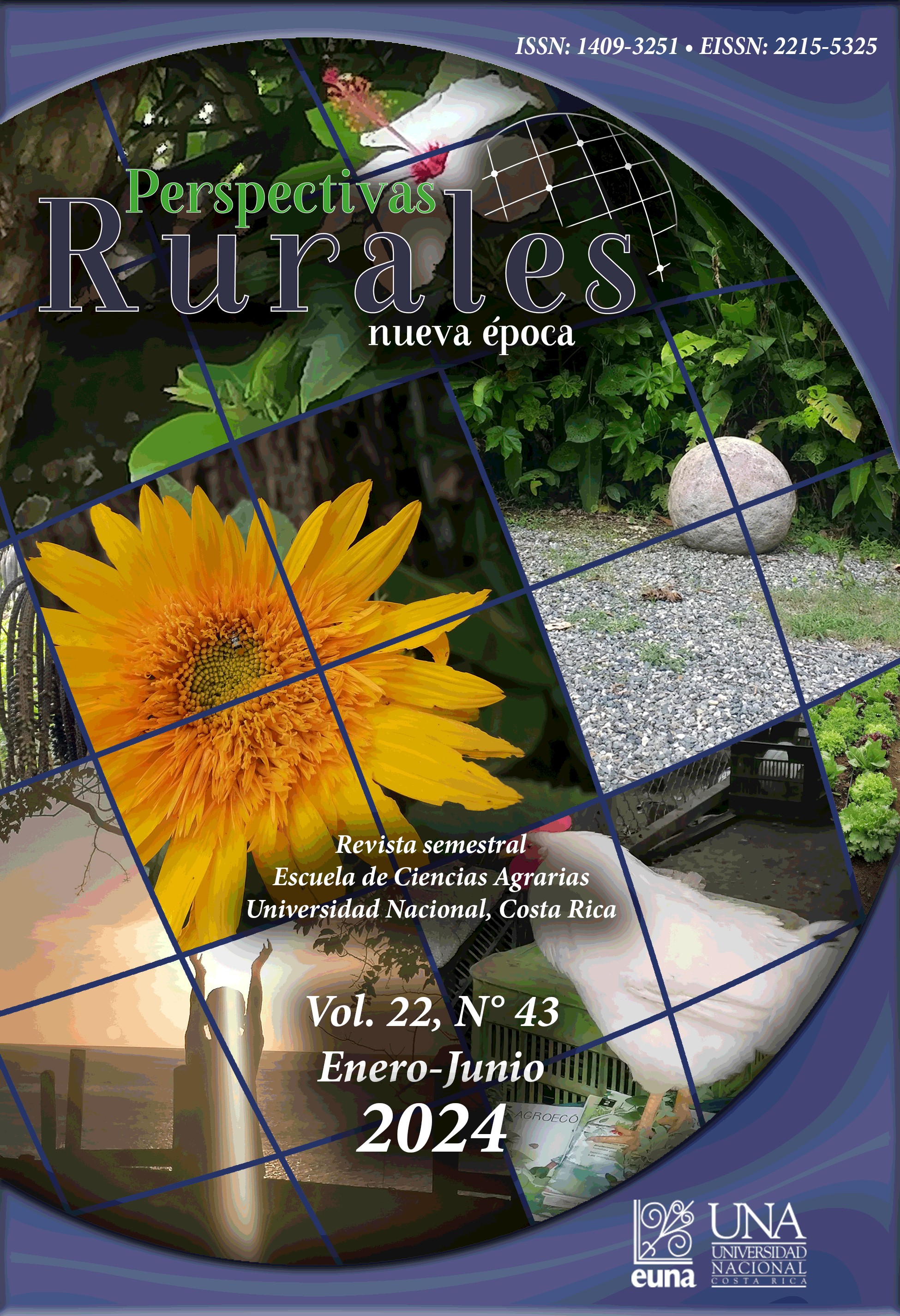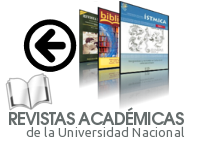Agrobiodiversity in home gardens and food and nutritional security of households in Monteverde, Costa Rica
DOI:
https://doi.org/10.15359/prne.22-43.10Keywords:
agrobiodiversity, home gardens, food and nutrition securityAbstract
Agrobiodiversity is believed to be associated with a wider diversity of diets and a reduction in food and nutrition insecurity (FNI). Consequently, agrobiodiversity of home gardens and their potential impact on food and nutrition security (FNS) in households in San Luis, Monteverde, an area that previously experienced high levels of FNI, was researched.
A total of 23 households with family gardens was assessed, and the persons responsible for the gardens were interviewed to gather information about their households and their gardens. Additionally, plant and animal species were identified and their uses in those spaces were reported.
To measure household FNS, a scale focusing on the access component was applied. Results indicated that approximately 65.2% of households experienced some degree of FNI. Analyzing the possible correlation between agrobiodiversity and household FNS revealed a trend, households with more diverse home gardens tended to exhibit better FNS outcomes than home gardens with fewer species.
These findings suggest that well-managed agrobiodiversity in family gardens can play a significant role in improving the FNS of rural families.
References
Ali-Khan, R., Azid, T. y Toseef, M. (2012). Determinants of food security in rural areas of Pakistan. International Journal of Social Economics; Bradford, 39(12), 951-964. http://doi.org./10.1108/03068291211269082
Asociación de Desarrollo Integral de San Luis. (30 de octubre de 2023). ¿Quiénes somos? San Luis ADISL. http://sanluis.or.cr/es/inicio/
Barbhuiya, A. R., Sahoo, U. K. y Upadhyaya, K. (2016). Plant diversity in the indigenous home gardens in the eastern Himalayan Region of Mizoram, Northeast India. Economic Botany; St. Louis, 70(2), 115-131. https://doi.org/10.1007/s12231-016-9349-8
Baudron, F., Chavarría, J., Remans, R., Yang, K. y Sunderland, T. (2017). Indirect contributions of forests to dietary diversity in Southern Ethiopia. Ecology and Society, 22(2). https://doi.org/10.5751/ES-09267-220228
Brenes, J., VanDusen, K. y Welch, J. (2016). Caminos hacia la resiliencia al cambio climático en Monteverde, Costa Rica. Fondo Comunitario Monteverde. https://corclima.org/manuales-y-panfletos/
Cahuich, D. (2012). La calidad de vida y el huerto familiar, desde la percepción ambiental de las familias de X-Mejía, Hopelchén, Campeche [tesis doctoral, El Colegio de la Frontera Sur]. http://bibliotecasibe.ecosur.mx/sibe/book/000052247
Cano, C. E. (2015). Huertos familiares: Un camino hacia la soberanía alimentaria. Revista Pueblos y Fronteras Digital, 10(20), 70-91. https://doi.org/10.22201/cimsur.18704115e.2015.20.33
Castañeda-Navarrete, J. (2021). Homegarden diversity and food security in southern Mexico. Food Security, 13(3), 669-683. https://doi.org/10.1007/s12571-021-01148-w
Coates, J., Swindale, A. y Bilinsky, P. (2007). Escala del Componente de Acceso de la Inseguridad Alimentaria en el Hogar (HFIAS) para la medición del acceso a los alimentos en el hogar: Guía de indicadores (v. 2). Academia para el Desarrollo Educativo.
Cowherd, R. (2012). The effects of food insecurity on mental wellbeing in Monteverde Costa Rica. University of South Florida. http://scholarcommons.usf.edu/cgi/viewcontent.cgi?article=5498ycontext=etd
Das, T. y Das, A. (2015). Conservation of Plant Diversity in Rural Homegardens with Cultural and Geographical Variation in Three Districts of Barak Valley, Northeast India1. Economic Botany, 69(1), 57-71. https://doi.org/10.1007/s12231-015-9299-6
Dietrich, J. (2011). Gendered division of labour in homegardens in Calakmul, Campeche, Mexico. University of Natural Resources and Applied Life Sciences.
FAO. (2002). Nutrición humana en el mundo en desarrollo. Mejoramiento de la seguridad alimentaria en el hogar. https://www.fao.org/3/W0073S/w0073s13.htm#bm39x
FAO. (2007). Agricultura y desarrollo rural sostenible (ADRS): La ADRS y la agroecología (Sumario de política 16 16). http://www.fao.org/family-farming/detail/es/c/336200/
FAO, OPS, WFP y UNICEF. (2018). Panorama de la seguridad alimentaria y nutricional en América Latina y el Caribe 2018. Santiago (p. 113). http://www.fao.org/3/CA2127ES/CA2127ES.pdf
Figueroa, D. (2003). Seguridad Alimentaria Familiar. RESPYN Revista de Salud Pública y Nutrición, 4(2). http://respyn.uanl.mx/index.php/respyn/article/view/109
Fuster, M., Messer, E., Palma, P., Deman, H. y Bermudez, O. (2014). ¿Se considera la alimentación saludable parte de la seguridad alimentaria y nutricional?: Perspectivas desde comunidades pobres de El Salvador. Perspectivas en Nutrición Humana, 16(1), 11-24.
Gautam, T. y Mandal, T. (2018). Effect of disturbance on plant species diversity in moist tropical forest of eastern Nepal. Our Nature, 16(1). https://doi.org/10.3126/on.v16i1.21558
González, W., Jiménez, A., Madrigal, G., Muñoz, L. M. y Frongillo, E. (2008). Development and validation of measure of household food insecurity in urban Costa Rica confirms proposed generic questionnaire. The Journal of Nutrition, 138(3), 587-592. https://doi.org/10.1093/jn/138.3.587
Himmelgreen, D., Romero, N., Amador, E. y Pace, C. (2013). Tourism, economic insecurity, and nutritional health in rural Costa Rica: Using syndemics theory to understand the impact of the globalizing economy at the local level. Annals of Anthropological Practice, 36(2), 346-364. https://doi.org/10.1111/napa.12008
Himmelgreen, D., Romero, N., Vega, M., Cambronero, H. y Amador, E. (2006). “The tourist season goes down but not the prices.” Tourism and food insecurity in Rural Costa Rica. Ecology of Food and Nutrition, 45(4), 295-321. https://doi.org/10.1080/03670240600848753
Holdridge, L. (1987). Ecología basada en zonas de vida. IICA.
Hollenbeck, E. (2014). Monteverde: Ecology and conservation of a tropical cloud forest - 2014 updated chapters (N. Nadkarni y N. Wheelwright, eds., 2014.a ed.). University Press. https://digitalcommons.bowdoin.edu/scholars-bookshelf/5
Ickowitz, A., Powell, B., Salim, M. y Sunderland, T. (2014). Dietary quality and tree cover in Africa. Global Environmental Change, 24(Supplement C), 287-294. https://doi.org/10.1016/j.gloenvcha.2013.12.001
Kabir, M. y Webb, E. (2009). Household and homegarden characteristics in southwestern Bangladesh. Agroforestry Systems; The Hague, 75(2), 129-145. https://doi.org/10.1007/s10457-008-9142-5
Kappelle, M., Avertin, G., Juárez, M. y Zamora, N. (2000). Useful plants within a campesino community in a Costa Rican nontane cloud forest. Mountain Research and Development, 20(2), 162-171. https://doi.org/10.1659/0276-4741(2000)020[0162:UPWACC]2.0.CO;2
Kumar, B. y Nair, P. (2004). The enigma of tropical homegardens. Agroforestry Systems; The Hague, 61-62(1-3), 135-152. https://doi.org/10.1023/B:AGFO.0000028995.13227.ca
Méndez, V., Lok, R. y Somarriba, E. (2001). Interdisciplinary analysis of homegardens in Nicaragua: Micro- zonation, plant use and socioeconomic importance. Agroforestry Systems; The Hague, 51(2), 85-96. https://doi.org/10.1023/A:1010622430223
Ministerio de Salud. (2011). Política Nacional para la Seguridad Alimentaria y Nutricional 2011-2021 (p. 54) [Política nacional]. https://www.ministeriodesalud.go.cr/index.php/biblioteca-de-archivos-left/documentos-ministerio-de-salud/ministerio-de-salud/planes-y-politicas-institucionales/planes-institucionales/706-politica-nacional-de-seguridad-alimentaria-y-nutricional-2011-2021/file
Ministerio de Salud. (2020). Prevalencias de inseguridad alimentaria en Costa Rica. https://www.ministeriodesalud.go.cr/index.php/biblioteca-de-archivos-left/documentos-ministerio-de-salud/vigilanci
Neulinger, K., Vogl, C. y Alayón-Gamboa, J. (2013). Plant Species and Their Uses In Homegardens of Migrant Maya and Mestizo Smallholder Farmers In Calakmul, Campeche, Mexico. Journal of Ethnobiology, 33(1), 105-124. https://doi.org/10.2993/0278-0771-33.1.105
Ng’endo, M., Bhagwat, S. y Keding, G. (2017). Contribution of nutrient diversity and food perceptions to food and nutrition security among smallholder farming households in Western Kenya: A case study. Food and Nutrition Bulletin, 379572117723135. https://doi.org/10.1177/0379572117723135
Rivas, G. (2014). Huertos familiares: Para la conservación de la agrobiodiversidad, la promoción de la seguridad alimentaria y la adaptación al cambio climático. Ambientico, 243, 4-9.
Rivas, G. y Cortés, A. (2013). El huerto familiar: Algunas consideraciones para su establecimiento y manejo. https://doi.org/10.13140/2.1.1712.9287
Rodríguez, V. y Montero, M. (2020). El efecto sucesor y el proceso de integración generacional: Temas clave en la sucesión familiar agrícola. E-Agronegocios, 6(2), 61-81. https://doi.org/10.18845/ea.v6i2.5210
Ruiz, E., David, H., Romero, N. y Peña, J. (2015). Using a biocultural approach to examine food insecurity in the context of economic transformations in rural Costa Rica. Annals of Anthropological Practice, 38(2), 232-249. https://doi.org/10.1111/napa.12054
Sander, L. y Vandebroek, I. (2016). Small-scale farmers as stewards of useful plant diversity: a case study in Portland Parish, Jamaica. Economic Botany, 70(3), 303-319. https://doi.org/10.1007/s12231-016-9354-y
Setzer, M., Moriarity, D, Lawton, R., Setzer, W., Gentry, G. y Haber, W. (2003). Phytomedicinal potential of tropical cloud forest plants from Monteverde, Costa Rica. Revista de Biología Tropical, 51(3-4), 647-673.
SINAC. (2016). Diagnóstico de la Zona Protectora Arenal Monteverde. http://canjeporbosques.org/wp-content/uploads/2017/07/Diagn%C3%B3stico-y-Mapeo-de-Actores.pdf
Thamilini, J., Wekumbura, C., Mohotti, A., Kumara, A., Kudagammana, S., Silvan R. y Frossard, E. (2019). Organized homegardens contribute to micronutrient intakes and dietary diversity of rural rouseholds in Sri Lanka. Frontiers in Sustainable Food Systems, 3. https://doi.org/10.3389/fsufs.2019.00094
Tongco, M. (2007). Purposive sampling as a tool for informant selection. Ethnobotany Research and Applications, 5(0), 147-158. https://doi.org/10.17348/era.5.0.147-158
Traversa, I. y Alejano, R. (2013). Caracterización de los huertos familiares del norte de Uruguay y metodología para su diagnóstico. Revista de Ciencias Ambientales, 45(1), 72-87. https://doi.org/10.15359/rca.45-1.7
Williams, N., Carrico, A., Edirisinghe, I. y Jayamini, P. (2018). Assessing the impacts of agrobiodiversity maintenance on food security among farming households in Sri Lanka’s Dry Zone. Economic Botany, 72(2), 196-206. https://doi.org/10.1007/s12231-018-9418-2
Wright, S. (2014). Food sovereignty in practice: A study of farmer-led sustainable agriculture in the Philippines. En P. Andrée, J. Ayres, M. J. Bosia y M. J. Massicotte (eds.), Globalization and Food Sovereignty: Global and Local Change in the New Politics of Food (Studies in Comparative Political Economy and Public Policy) (pp. 199-227). University of Toronto Press.
Published
How to Cite
Issue
Section
License
Copyright (c) 2024 Jéssica Arias Ramírez, Marcela Dumani Echandi

This work is licensed under a Creative Commons Attribution-NonCommercial-NoDerivatives 4.0 International License.
![]()
Revista Perspectivas Rurales. Nueva Época se encuentra bajo una licencia Creative Commons Reconocimiento-NoComercial-CompartirIgual 4.0 Internacional License.
Creado a partir de la obra en http://www.revistas.una.ac.cr/index.php/perspectivasrurales
Los autores/as que publiquen en esta revista aceptan las siguientes condiciones:
- Los autores/as conservan los derechos de autor y ceden a la revista el derecho de la primera publicación, con el trabajo registrado con la Licencia Creative Commons Atribución-NoComercial-CompartirIgual 4.0 Internacional, que permite a terceros utilizar lo publicado siempre que mencionen la autoría del trabajo y a la primera publicación en esta revista.
- Los autores/as pueden realizar otros acuerdos contractuales independientes y adicionales para la distribución no exclusiva de la versión del artículo publicado en esta revista (p. ej., incluirlo en un repositorio institucional o publicarlo en un libro) siempre que indiquen claramente que el trabajo se publicó por primera vez en esta revista.
- Se permite y recomienda a los autores/as a publicar su trabajo en Internet (por ejemplo en páginas institucionales o personales) antes y durante el proceso de revisión y publicación, ya que puede conducir a intercambios productivos y a una mayor y más rápida difusión del trabajo publicado.






 :
: 
